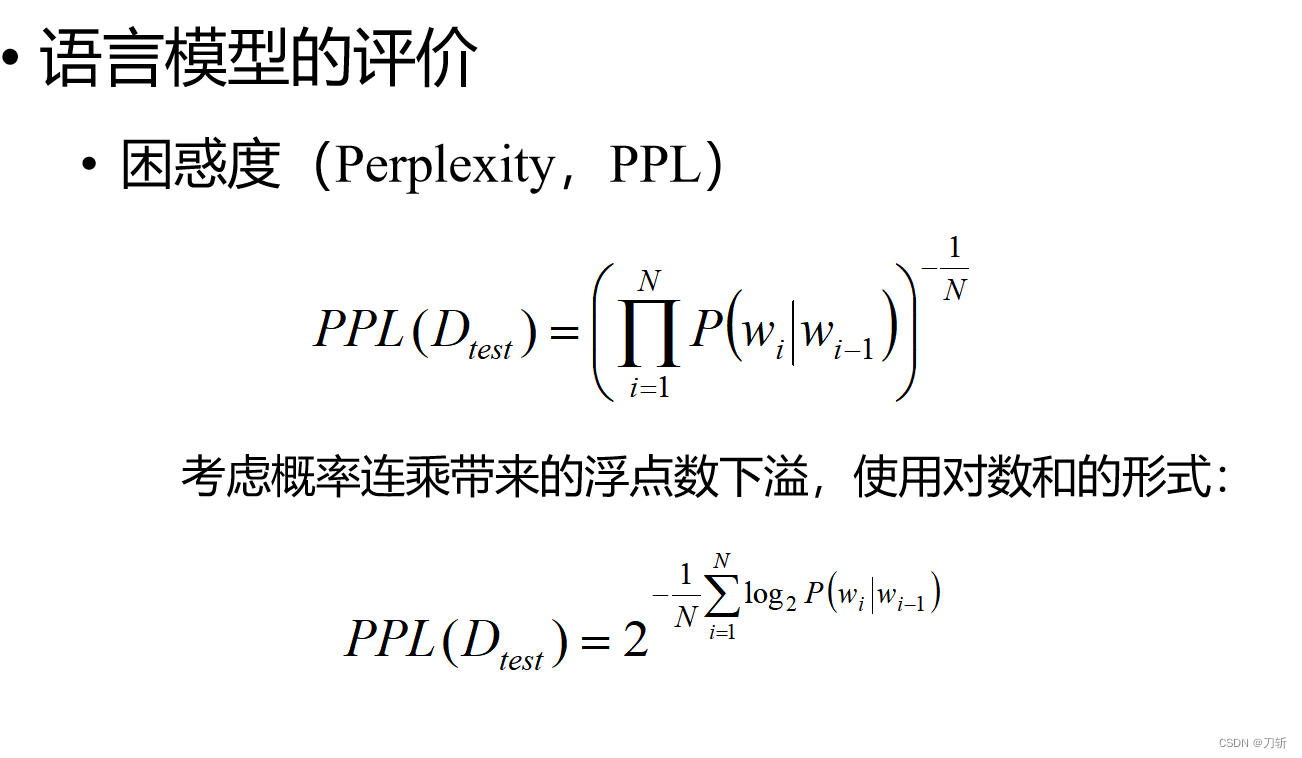训练语料和测试语料为pku和msr的txt文本,在每个txt中,每句话自身的单词之间由两个空格隔开,文本需为ANSI编码,每个字或符号都由两个char型组成。
模型为一个map,map的键为n-1个单词连在一起,形成的一个string,map的值为另一个map2,map2的键为第n个单词,map2的值为此单词出现次数,例如三句话:我 喜欢 夏天、我 喜欢 冬天、我 不喜欢 春天。得到的模型为:
我→喜欢→2
→不喜欢→1
喜欢→夏天→1
→冬天→1
不喜欢→春天→1

// 读文件.cpp : 此文件包含 "main" 函数。程序执行将在此处开始并结束。
//
#include <iostream>
#include<string>
#include<map>
#include<fstream>
using namespace std;
struct value//map table的值的结构类型,也是一个map,
{
map<string, int>times; //此map的键为n元文法的第n个词,map的值为第n个词在前n - 1个词后面出现的次数
int AllWordsTimesAfterKey = 0;//前n个词出现的总次数
};
void addbos(char ch[],int n)//n元文法则在句首添加n-1个bos
{
int i = 0;
for (i = 0; i < (n - 1) * 4; i++)
{
ch[i] = ' ';
i++;
ch[i] = ' ';
i++;
ch[i] = 'b';
i++;
ch[i] = 'b';
}
ch[i] = ' ';
ch[i + 1] = ' ';
}
void addtxt(char ch[], char chtxt[], int n)//将训练文本的一句话chtxt,复制到ch中,ch的前几项为bos
{
int i = 0;
while (chtxt[i] != '\0')
{
ch[(n - 1) * 4 + i + 2] = chtxt[i];
i++;
}
ch[(n - 1) * 4 + i + 2] = '\0';
}
void addeos(char ch[])//在句尾添加1个eos
{
int i = 0;
while (ch[i] != '\0')
i++;
if (ch[i - 1] == '\n'&&ch[i-2]!=' ')//msr的句尾无空格
{
ch[i - 1] = ' ';
ch[i] = ' ';
ch[i + 1] = 'e';
ch[i + 2] = 'e';
ch[i + 3] = '\0';
}
if (ch[i - 1] == '\n' && ch[i - 2] == ' ')//pku的句尾有两个空格
{
ch[i - 1] = 'e';
ch[i] = 'e';
ch[i + 1] = '\0';
}
}
string makekey(char ch[], int n, int wordbegin[], int wordend[])//map table的键值,n元文法则键为前n-1个字连起来
{
string key;
for (int i = wordbegin[0]; i <= wordend[n - 2]; i++)
{
key = key + ch[i];
}
return key;
}
string makevalue(char ch[], int n, int wordbegin[], int wordend[])//map table的值的string,n元文法中的第n个词,即前面文法所得的结果
{
string value;
for (int i = wordbegin[n - 1]; i <= wordend[n - 1]; i++)
{
value = value + ch[i];
}
return value;
}
void train(FILE*fp,map<string,value> & table,int n)
{
char ch[4096],chtrain[4096];//chtxt为读取的原文,ch为添加了bos和eos后的格式
addbos(ch,n);//n元文法则在句首添加n-1个bos
while (fgets(chtrain, 4096, fp)!=NULL)
{
int i = 0;
addtxt(ch, chtrain, n);
addeos(ch);//在句尾添加1个eos
string nword[10];//假设最多有10元文法
int wordbegin[10], wordend[10];//最多10个单词的首尾位置
for (i = 0; i < 10; i++)
{
wordbegin[i] = 0;
wordend[i] = 0;
}
i = 0;
int wordnum=0; //记录在一句话中,读到了几个词,每读到n个词,则计算一次
while (ch[i] != '\0')
{
if (ch[i] == ' ' && ch[i + 1] != ' ')//一个词的开头
wordbegin[wordnum] = i + 1;
if ((ch[i] != ' ' && ch[i + 1] == ' ') || (ch[i - 1] == 'e')&&ch[i] == 'e')//一个词的末尾,eos的后面没有空格
{
wordend[wordnum] = i;
wordnum++;
}
i++;
if (wordnum == n)//一次读入了n个词
{
//table:前n-1个词为键,struct value为值
//value:第n个词为键,读取次数times为值
string key = makekey(ch, n, wordbegin, wordend);//map的key,n元文法则键为前n-1个字连起来
string valuestring=makevalue(ch,n,wordbegin,wordend);//map的value的string,n元文法中的第n个词,即前面文法所得的结果
if (table.count(key) == 1)//前n - 1个字的组合出现过
{
table[key].AllWordsTimesAfterKey++;
if (table[key].times.count(valuestring) == 1)//最后一个词也出现过
{
int time = table[key].times[valuestring] + 1;//出现次数加一
table[key].times.erase(valuestring);//前n-1个词为key所对应的,第n词为valuestring项删除
table[key].times.insert(pair<string, int>(valuestring, time));//前n-1个词为key所对应的,第n词为valuestring项,次数为time
i = wordend[0] + 1;//从第二个词开始重新计算
}
if (table[key].times.count(valuestring) == 0)//最后一个词没出现过
{
table[key].times.insert(pair<string, int>(valuestring, 1));
i = wordend[0] + 1;//从第二个词开始重新计算
}
}
if (table.count(key) == 0)//前n-1个字的组合没出现过
{
value word;
word.times.insert(pair<string,int>(valuestring,1));//最后一个词出现1次
table.insert(pair<string, value>(key, word));//前n-1个词的组合,后边接最后一个词
table[key].AllWordsTimesAfterKey = 1;
i = wordend[0] + 1;//从第二个词开始重新计算
if (ch[i] == '\0')
break;
}
wordnum = 0;
}
}
}
for (int cc = 0; cc < 2048; cc++)
{
ch[cc] = '\0';
}
/*for (auto it = table.begin(); it != table.end(); it++)
{
cout << "开头词为: " << it->first << "\n";
for (auto it2 = it->second.times.begin(); it2 != it->second.times.end(); it2++)
{
cout << " 后接词为: " << it2->first << " 时 " << "出现次数为:" << it2->second << "\n";
}
}*/
}
void test(map<string, value>table, FILE* fp, int n, char txtname[])
{
char ch[4096], chtest[4096];
addbos(ch,n);
ofstream File;
string test_txt = "";
int i = 0;
for (i = 0; txtname[i] != '.'; i++)
{
}
txtname[i] = '\0';
for (i = 0; txtname[i] != '\0'; i++)
{
test_txt = test_txt + txtname[i];
}
char nn[2];
itoa(n,nn,10);
test_txt = test_txt + "的" + nn + "元困惑度计算文件.txt";//输出结果的文件名
File.open(test_txt);
while (fgets(chtest, 4096, fp) != NULL)
{
addtxt(ch, chtest, n);
addeos(ch);
string nword[10];//假设最多有10元文法
int wordbegin[10], wordend[10];//最多10个单词的首尾位置
int N = 0;//一句话中的单词数量
for (i = 0; i < 10; i++)
{
wordbegin[i] = 0;
wordend[i] = 0;
}
i = 0;
int wordnum = 0;//每从一句话中读入n个词,则计算一次
double ppl = 0;//一句话的困惑度
while (ch[i] != '\0')
{
if (ch[i] == ' ' && ch[i + 1] != ' ')//一个词的开头
{
wordbegin[wordnum] = i + 1;
N++;
}
if ((ch[i] != ' ' && ch[i + 1] == ' ') || (ch[i - 1] == 'e') && ch[i] == 'e')//一个词的末尾
{
wordend[wordnum] = i;
wordnum++;
}
i++;
if (wordnum == n)//一次读入了n个词
{
//table:前n-1个词为键,struct value为值
//value:第n个词为键,读取次数times为值
string key = makekey(ch, n, wordbegin, wordend);//map的key,n元文法则键为前n-1个字连起来
string valuestring = makevalue(ch, n, wordbegin, wordend);//map的value的string,n元文法中的第n个词,即前面文法所得的结果
int onewordtimes = 0;
if (table.count(key) == 1)
{
if (table[key].times.count(valuestring) == 1)
{
double valuestring_times = table[key].times[valuestring];
double key_times= table[key].AllWordsTimesAfterKey;
double gailv = valuestring_times / key_times;
double gailv_log = log(gailv) / log(2);
ppl = ppl + gailv_log;//计算一句话中,每两个词的困惑度
}
}
wordnum = 0;
i = wordend[0] + 1;
}
}
ppl = ppl / N;
ppl = ppl * (-1);
ppl = pow(2, ppl);//一句话中每个词的困惑度加起来
i = (n - 1) * 4 + 2;//不输出“bb”
while (ch[i] != 'e')
{
File << ch[i];
i++;
}//结果文件
File << " 句子困惑度为: " << ppl << endl;
}
File.close();
}
void ui(map<string,value> & table)
{
int n = 2;
int traintxt_number = 1;
char txtname[40];
FILE* fp;
int addone = 0;
while (traintxt_number)//判断是否有新训练语料输入
{
cout << "请输入训练文档的文件名,如“D:\\training_msr.txt”,注意txt文档应为ANSI编码方式";
cin >> txtname;
cout << "输入文法元数";
cin >> n;
cout << "句子的开头添加了n-1个“bb”,句子的结尾添加了1个“ee”" << "\n";
fopen_s(&fp, txtname, "r");
train(fp, table, n);//读取训练语料,构建模型table
fclose(fp);
cout << "\n" << "训练语料为:" << txtname << " 的n元文法模型已完成";
for (int i = 0; i < 40; i++)
{
txtname[i] = '\0';
}
cout << "\n" << "是否添加新的训练语料文件,是请输入1,不是请输入0" << "\n";
cin >> traintxt_number;
}
cout << "请输入测试文档的文件名,如“D:\\test_msr.txt”,注意txt文档应为ANSI编码方式";
cin >> txtname;
fopen_s(&fp, txtname, "r");
test(table, fp, n, txtname);
cout << "计算结果输为在“D:\\" << txtname << "的困惑度计算文件.txt”";
}
int main()
{
map<string, value>table;//table的数据结构:table的键为n元文法的前n-1个词,table的值为value型
ui(table);
}





















 1040
1040











 被折叠的 条评论
为什么被折叠?
被折叠的 条评论
为什么被折叠?








